|
Colonel James H. Leach -
"The sweetest man who ever lived,"
Marion Leach, 2007
Colonel James H. Leach was born in Houston, TX on April
7, 1922. He began US Army service when he joined the Texas National Guard
on June 19, 1938 at the age of 16.
When Gen. Patton began his summer dash across France in
1944, Jimmie Leach was commander of Company B, 37th Tank Battalion, 4th Armored
Division, serving under the legendary Lt. Col Creighton Abrams. He had
trained for four years as a tanker. He was uniquely prepared.
Jimmie was wounded five times in Europe, received the
Distinguished Service Cross for his heroism at Bigonville on Dec 24, 1944 and
three days later he captured and guarded the entry of the 37th into Bastogne in
relief of the 101st Airborne.
After WWII, Jimmie served in Korea on the island of
Cheju, moderating the angry wrath among island natives, off-island Koreans and
returning Koreans who had served in the hated Japanese Army.
He married Marion Heirs Floyd in 1951 and spent four years in
Germany guarding the Fulda Pass against the seemingly inevitable roll of Russian
tanks west into the Rhineland.
He assumed Armored Brigade Command as a Colonel in
the late 1960's, was assigned to Vietnam as senior advisor with the 5th ARVIN division,
then, in 1969 assumed command of the 11th Armored Cavalry, replacing George
Patton III His aggressive leadership of the 11th is still remembered with
awesome respect by his subordinates and his peers. For the second time, in
his second war he heard the report that, "Jimmie Leach is the bravest man I ever
knew."
Jimmie Leach led the Army's Armor Branch with skill and
compassion in the early 1970's, managing the portfolios of some 6000 Army officers.
Men like Gen Fred Franks and the current Secretary of the Department of Veterans
Affairs, Gen Eric Shinseki, report that Jimmie was responsible for their very
careers as he fought to keep these future General Officers in the Army although
each had lost a limb to wounds in Vietnam.
His defense of one young officer earned him the enmity
of Gen William Westmoreland and he was passed over for promotion as General
Officer. His son describes the scene at his home, with great friend, Gen
Creighton Abrams on hand offering support, but not interfering with this final
decision, as a wake.
Jimmie Leach retired from the Army and worked for
Teledyne for 13 years from 1972-1985. He kept his service to the Army
paramount and carried out the legislative and financial work leading to the
United States Armored Forces Monument near Arlington National Cemetery.
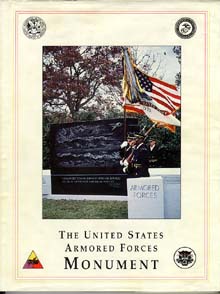
Jimmie Leach now lives in South Carolina where, over
the last twenty-plus years he has supported the causes of soldiers and
soldiering with unflagging zeal. He has visited the battlefields of France
and the Ardennes more than ten times, placing monuments and memorials to the men
who came there with him - and never came home. He has made peace with his
enemies in Germany - and Vietnam and traveled through both South and North
Vietnam to relook at the places and events there.
Jimmie works hard still to effect the expansion of the
Beaufort National Cemetery in Beaufort, SC, a cemetery established under
President Lincoln whose growth is threatened by neighborhood encroachment.
In 2006, Jimmie Leach spoke at the James H Leach
ReadinessCenter, a new SC National Guard facility built with funds wrested
from Congress through Jimmie's unremitting pressure on the late Sen. Strom
Thurmond. He reminded the local Guardsmen, who were on their way to
Afghanistan, that they continued a proud National Guard tradition of more than
two centuries, to which he had been attached for nearly 70 years. And his
message was clear: soldiers must train for war and never become complacent
with the present situation.
Jimmie Leach and I have spent hundreds of hours
recording his story. In September 2007 I was with him in the Galt Hotel in
Louisville when a middle aged man approached me and said, "Is that Col. Leach?"
I said yes and he said to Jimmie, "I want to thank you for saving my life in
Vietnam."
Col. James H Leach died at 87 on Dec. 17, 2009.
He was driving his car near his home in South Carolina when he suffered a heart
attack. He was with us for 32031 days. Very few of them were wasted.
jimmieleach.us.
Matt Hermes
Copyright 2009 Matthew E Hermes
|
6. Utah Beach; Jimmie Leach in Combat
(An excerpt from Tanker Jimmie Leach. In this
segment Jimmie Leach crosses into France as a Platoon Leader in the Co. B of the
37th Tank Battalion. He is uncertain, cautious and is wounded. He
tells us how spiritual contact and physical action suppresses his fears.)
I n early
July the 37th Tank Battalion with 1st Lieut. Jimmie Leach in command
of the 1st Platoon, backed its tanks onto Landing Craft
Tanks (LCTs) at Portsmouth Harbor. It was so orderly. The Battalion,
its three medium tank companies, its light tank company, headquarters company,
quartermaster and maintenance company counted more than 150 vehicles and nearly
70 tanks. In 1979 Sgt
Francis Magliozzi, Harvard, 1936, Company Clerk turned tank gunner who was
denied promotion to 2nd Lieutenant only because he was seriously wounded on Nov
11, assembled the roster of Company B tanks and crew that left Portsmouth.
There were 116 men in Jimmie Leach's Company B. The Company Commander,
Capt. Tiegs, had a headquarters platoon with two tanks, an assault gun, two
peeps, a cook truck, a tank retriever and a half-track. And there were 15
Sherman tanks in three platoons. Never again would there be a full
complement of 15 tanks with full crew of five men each:
37th Tank Battalion
Company B
1st Platoon |
2nd Platoon |
3rd Platoon |
Blockbuster
Leach
Coffee
Brown
Boggs (KIA)
Popovitch (KIA) |
Boilermaker
Bohn
Peskar
McVicker (KIA)
Porter
Rhoads |
Brother Toby
Marston
Cueto
Niski
Chelmecki
Martin |
Betty Boop
Fitzpatrick
Creviston
Clark (KIA)
Baay
Reynolds |
Bock Beer
Langmeier
Hauptman
Ross (KIA)
Moe
Miller |
Brooklyn Boy
Farese (KIA)
Bordner
Troxell
Parks (KIA)
Ritland (KIA) |
Bulldozer
Morphew
Sandrock
Hale
Kelley (KIA)
Tyler |
Ballantine
Del Vecchio
Wenrich (KIA)
Gellman
Machen
Simcik |
Blenheim
Whiteside (KIA)
Chernick (KIA)
McGuire (KIA)
Paulus
Ayotte |
Berlin Bound
Grady
Litherland
Nelsen
Caisey
Fitzgerald |
Budweiser
Lewis
Checki
Grieb
Wright (KIA)
Kaczmarek |
Blondie
Heintz
Ginoli (KIA)
Daly
Irish
Graham |
Beer Barrel
Kobela
Weitzman
Simo (KIA)
Levins
Yaremchuk |
Blue Ribbon
Sowers
O'Hearn
Bradley (KIA)
Drew
Cunningham |
Beaufighter
Krassner
Gregor
Cariello
Peck (KIA)
Gagliardi |
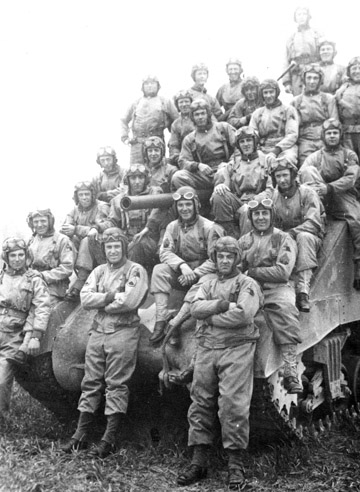
37th Tank
Battalion, 1st Platoon. Platoon Leader Lt. Jimmie Leach seated on cannon
This Portsmouth roster was a
snapshot, of course. Within weeks tanks would be lost; some were replaced
but the Company would not ever be restored to full strength. Within weeks
men would die; the three of the first four would die without any intervention by the German
Army. Eighteen of these original 75 would be left dead in Europe along
with Blume, Connelly, Kaplin and Tuchinsky from the HQ platoon. Some would be
replaced, and the replacements, too, would die.
Jimmie remembers his
channel transport was LCT838 and the small
craft was loaded with his platoon of five tanks under the watchful eyes of three
British crewmen who leaned on the gunwale above the deck and smoked cigarette
after cigarette. “We had a mock-up of an LCT at Ft Knox and they trained the
tank crews there to load up and so some were familiar with that system,” Jimmie
said. The LCTs rested off Portsmouth for a time as the flotilla assembled then
they set off for France, for Utah Beach. It was July 13, five weeks after D Day
and the beaches were clear of Germans. “There was a squall on the crossing and
my tank crews were in and under the tanks but I was up on the bridge with the
three British officers and they set a mattress down across the bridge so I could
rest a little bit but they had to hot bunk it because they were on duty all the
time,” Jimmie said. Their landing at Utah was not without complications and it
is certain Lt. Leach’s platoon was thankful they were not under direct fire.
“When we landed at Utah we were stopped because our vessel hit the edge or a berm of a bomb crater and we let the ramp down and it went straight down into
the crater so we had to wait for low tide and a bulldozer came out and scraped
sand into the hole and we could get our tanks off.”
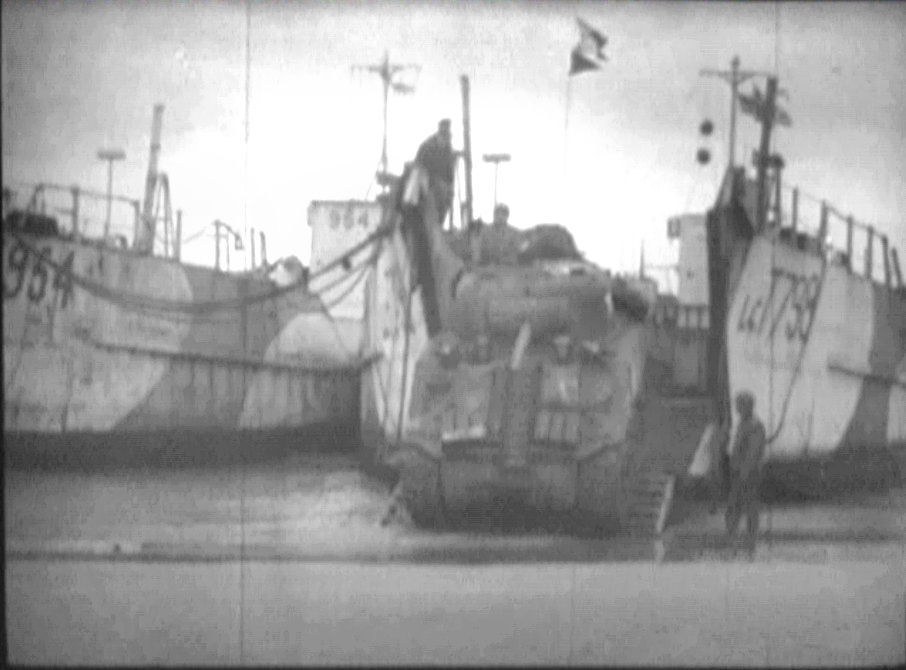
4th AD Tank Coming off an LCT at Utah Beach
Photo from the collection of Dan Fong [afvphoto@hotmail.com]
Company Commander Tiegs was
to land on a later LCT and for a time Jimmie and his tanks were lost. ”Tiegs
came on a separate boat. I arrived first at Utah and no one knew where I was
supposed to go so I flagged down an 82nd airborne sergeant in a Jeep
and asked them where I was supposed to go. It was a waste of time and I got
into his Jeep and we went to find where we were to go. There was fighting
nearby with the 79th Infantry Division and I remember that when I was
sure where I was supposed to go I was so afraid we might step on some mines so
(when we got there) I ran my tanks round and round behind the hedgerow so that
my soldiers could go back there safely,” Jimmie said. So the 37th
Tank Battalion, 4th Armored Division was on the ground in France.
For these young men, for Lt. Jimmie Leach, platoon leader, Company B, the sounds
of combat were real. Jimmie Leach’s training that had begun so long ago in the
scrub of Texas as a 16 year old with World War I uniforms and broken down combat cars was to be
tested but there would be no certainty how Lt. Leach or any individual soldier
would fare when they knew they were in sight of an enemy intent on killing them.
“At that time the 79th Infantry
was fighting ahead of us and I remember the 749th Tank Battalion was
their support. And their truck drivers would come back and come past us. Tell
us about the war we would ask them. We wanted info from a PFC truck driver. We
were so concerned about mines and booby traps. There was a gate in the
hedgerows so the farmer could get in there so I examined the latch, looking for
wires and I unlatched it, and it didn’t blow up so then I had my tank come up
and push it open, go in the field. Then we would go all the way around in the
field to find mines so the soldiers could walk in there.
“So that first night, someone started
shooting, then a lot of sympathetic firing and I got my guys ‘If you are not
seeing anything, stop shooting,’” Jimmie said.
The 4th
Armored was stalled in the hedgerows of Normandy for about two weeks after the
landing. There was sporadic fighting, small actions to take and hold the
rectangles of land separated by narrow lanes and surrounded by impenetrable
hedges. On July 22nd the Germans were shooting into his area
and Jimmie Leach and his corporal moved up to investigate. They were new
to this fighting, perhaps they went to get a peek at the field of fire. They
were walking along next to one of
these stout hedges; a shell exploded in the hedgerows. Jimmie felt a stinging in his calf and said,
“I think I’ve been hit.” The Corporal said, “Me too!.” The two men suffered
similar shrapnel wounds in their left leg. Medics scraped at Jimmie’s wound to
clean it and remove imbedded dirt and uniform cloth. The wound was treated with
sulfa and bandaged. This wound, for which Jimmie Leach received his first
Purple Heart, did not heal until the next winter. Every day it hampered Jimmie
when he mounted his Sherman Tank. “Step
here, step to the fender, hold on to the thing next to the light and pull
yourself up. There was an escape hatch under the driver and you could pull this
lever and the armor would drop to the ground. Otherwise the only way out was
through the turret hatch."
“Our Company had a maximum of 17 Sherman
tanks. (Including the two that Lt Col Abrams commandeered) They were absolutely quite good. The tanks were a tribute to the
manufacturers; Chrysler, Ford and Budd Locomotive made them. From an automotive
standpoint they were very good. Engines good, transmission, good, suspension
good. But the guns weren’t powerful enough and they didn’t have enough armor.
When I went back to the US in Feb 1945 we still had a number of tanks that we
brought over from the mainland.
“Early on Geuderian was the father of the
German light tanker force. As they grew they changed the suspension. They
eventually had the Panther 4. Their 75 mm shell would stand waist high. This gun would penetrate our tank from any angle. Our shell was much
smaller than theirs so they had longer range and could kill us. We could fit
around 50-60 rounds in the
tank, each weighing about 20 pounds. Theirs could kill
a tank from front or rear but I would have to close in quite a bit closer. The
Panther had a front slope on the armor and the shell would ricochet. We had to
hit them right in a crevice and that would kill the crew. Their Tiger had an
88mm gun and it could do so at greater range. I could kill the panther from the
side or the rear but from the front, no.
“We had three types of rounds: shot – solid
bullet, super shot for the .76, the High Explosive with a fuse on the end of it;
delay and super-quick that you set with a screwdriver. We put all our rounds on
delay so that if it fell short it might bounce and explode over the target. In
addition we took 6-10 rounds with a concrete-buster fuse. That one would permit
penetration before explosion. Then we had white phosphorous (WP). We had a WP
in the breech when reconnoitering to mark the target, screen the target or smoke
it. The smoke allowed you to hide from the other tanks. Shell cases got thrown
overboard. Ejected hot and thrown overboard. Throw them out the pistol port.
With a platoon of 5 tanks as I got the replacement with the 76mm guns I always
made certain I had one 75 in a platoon because only the 75 mm had the WP and I
wanted each platoon to have the advantage of this shell.
“I can’t personally claim killing any
tanks. It was a group effort. We knocked out 9 at Richecourt and lost three
from A Company. In the Arracourt battles our C Company under Lamison must have
knocked out about a dozen panthers of the 113th Panther brigade. I
participated in taking out some of the nine. We must have killed 20-25 at
Arracourt. My own tank was taken out at Lissez, killing my two men. You know I
lost two tanks and I was not in either one, I was on the ground. At Lissez I
was on the ground and they were shooting at them and I was out of the tank
backing them up and they stopped and a round went right into the side of the
tank and killed the driver and the bow gunner.
“I took Company command in August. Capt. Tiegs
had been wounded and he came back to join us and we had these double hatches on our turrets and
they would slip and slam closed," Jimmie said. Then Tiegs had his hands broken when
his hatch fell on him. Tiegs told Jimmy to take over because he needed to
be evacuated.
The 37th drove across to Brittany, then back
east, always on the move.
Fear:
When Jimmie Leach landed in France, how would he behave?
Fear Jimmie? “Well (pause) I don’t know. Somehow or other I did not avoid
dangerous spots. If there was a contact I would quickly go there to see if I
could influence it one way or another. By adding more troops or changing the
tactic or something. The only fear I had in WWII primarily was the fear of
antitank weapons because I knew how vulnerable our tank was. Soft armor you
know. And they could penetrate us with anything they had almost. Our guns
could knock out the lighter armor, the self propelled guns and could knock out
the Mark 4 but to get a Mark 5 we had to hit them on the flank or rear. And
we did knock out nine of them and I hit them all on the flank. They just
happened to engage A Company and I hit them on the flank. Begagng-Le_Petit
about Sept 18.”
Fear, Jimmie? “I prayed for it. I prayed
every night. Now it’s an interesting thing but I prayed for guidance every
night. As I said I was afraid of antitank weapons I wasn’t so much afraid of
mines although we would hit them occasionally I didn’t personally run over
any. I wasn’t in the two tanks I lost. I was dismounted on both of them.
But nevertheless I felt very vulnerable to the antitank weapons.”
Fear Jimmie? “I used to pray for the guidance that I would not make a mistake
that would cause my soldiers to die or get injured and I couldn’t prevent it
of course I tried to, and uh, my prayers were the same prayer my mother taught
me, ‘God make me a better boy,’ and on and on.
After we landed in Normandy and I had
been wounded and I found that I was able to move in and actually do things,
not sure of this but, reasonably so, I asked the Lord to give me permission to
say, ‘Make me a better man.’ And a better soldier and a better commander and
a better leader, more than a better boy. I said, ‘I think sir I’ve passed the
boy stage, I’m now leading soldiers in combat.’ And I prayed for their
guidance and their safety and that I give them good information. So from that
point on I started using, ‘God make me a better man.’ I still do that, every
night. I also pray for the Muslims every night. For a penetration of their
thinking of this suicidal idea they have that they go to heaven and get 30 or
60 virgins or some stupid idea and last night the nature channel had a segment
on religion. What’s heaven like? And they had a Muslim there – an American
Muslim, bearded and a little bit of an accent nevertheless he pointed out that
we are not supposed to kill ourselves in order to kill our enemy. That is
wrong. He took a strong stand on it. It was wrong. I don’t understand why
these groups of people, our Muslims are doing this. And he was a bearded rag
head and the whole smear. It was very impressive.”
Fear, Jimmie? “When
I went to Vietnam and all of a sudden I was in combat again, 25 years after
the first time, I asked for guidance every night, dear Lord. And I believe
the Muslims and the Jews all of us have a Supreme Being and we’re all talking
about the same guy! In all cases. Whoever God is, he’s up there someplace in
our minds but he doesn’t tell us to kill other people. We are forced to do
it. I had wonderful chaplains, too. One of my Catholic Priests in one of my
Squadrons wrote me a formal note about his service in the regiment. And how
it was a pleasure to work for me. But there’s where my conscience comes in.
I failed to recognize so many soldiers that should have been decorated for
good works. And my chaplains were outstanding. They were front line
soldiers.
Fear, Jimmie? “A nervous soldier that broke down and started whimpering and
crying, and I had several, both in Vietnam and WWII, I sensed I had more of
them in WWII than in Vietnam, I had no sympathy for them. For some reason. I
think you bite your lip and push yourself on through this affair. And I
relieved a forward observer, artillery, a lieutenant, who cowered. I relieved
an assault gun platoon leader who cowered. Nothing in their records, I just
took them out of action. And sent them to the rear. Gagliardi, one of my
Italian American guys from Brooklyn accidentally shot his own tank driver,
Peck. The driver was standing in front of the tank, and that bow gun.
Gagliardi was a
bow gunner and he was messing with his gun and two rounds went off bip-bip
just like that and went through Peck's back and the bullets came out his chest.
He himself hollered medic twice and then dropped. Gagliardi went to pieces.
Well, I had no sympathy for him. He was a careless damn fool. Here was this
man right in front of him. He had to know it because the hatch was open and
why he was on his gun I don’t know. Why he was messing with it with the man
standing right in front of it is beyond me. So I blessed him out to a
fare-the-well and Scotti our surgeon came up while I’m thrashing him about
saying you SOB you’ve killed a good man. The surgeon said, Jimmie you are
going to have two casualties, your own men got killed. I was furious. This
was a worthless son of a gun compared to Peck who was an outstanding soldier.
An older man. Good tank driver. Tank crewman, good soldier. And this other
bird I wanted to keep a boot in his tail to make him work. So I didn’t have
much sympathy for those breakdowns. In Vietnam I don’t remember running
across any of them but I remember several from WWII.”
(An excerpt of a work in progress)
8/31/09
Questions or comments: Contact Matt
Hermes
|
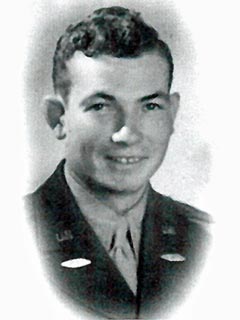
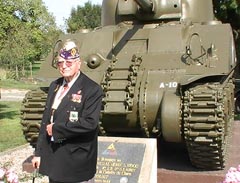
![]()

